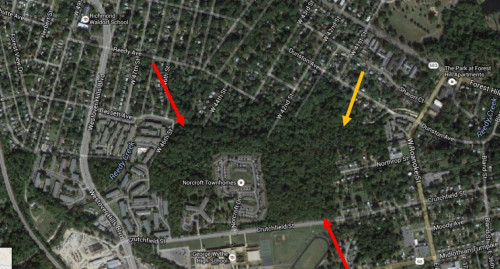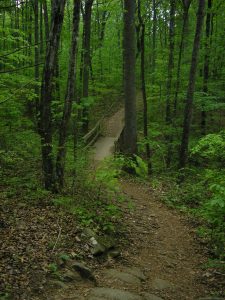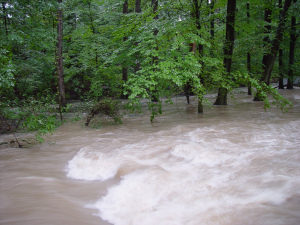We all agree that after the everyday hustles and bustles of this life, we need a relaxing place to rejuvenate. Whether it is a quiet meditation in your sitting room, a nap in your bedroom, a stroll in the woods, walking dogs in the neighborhood or yoga in the gym, the benefits we reap from such mundane tasks are invaluable. Now for a moment, think about what would happen if these opportunities for relaxation were no longer available. Would life be the same again?
This is exactly the situation that has placed Susan, a resident of Southern Richmond between a rock and a hard place. To her, the forests along the Reedy Creek are not just a wild place outside the comfort of her house, but rather a pristine environment where she delves into, to escape the bustles of life and emerge revitalized. Something as typical as the
chirping of the birds or the throbbing of waters of the creek against the rocky banks quell her. It is interesting to note the depth of connection that Susan feels with her environment as this shapes her view. Surely, it is this phenomenal outlook that helps us to appreciate small things that if we are not meticulous enough can easily overlook.
However, I believe Susan would not oppose any aims at improving the forests or stream conditions along the Reedy Creek. Human beings are by design created to want to achieve things in the most efficient way. It would surely be counter-intuitive for her to oppose such a proposal given the magnitude of satisfaction she derives from the area. Therefore, any form of antagonism to a proposed restoration of the creek should be a major call for attention, right? Susan and her neighbors are probably in a huge tussle that would change
their lives along the creek for good. With the general elections coming up in one week, it is interesting to note the myriad of anti-restoration signs within yards alongside campaign signs. Who knows, maybe this could be a foreshadow of the residents’ resolution to elect leaders who will have the best interest of the creek at heart.
That said, imagine of a situation where a city curbed crime by installing surveillance cameras at ‘convenient locations’ without first conducting a study to fathom the prevalence of crime rates in the city. Would this strategy be efficient in the long-term? This is exactly what the residents of Reedy creek feel the city of Richmond is trying to do with the proposition to restore the Reedy creek. It is elementary knowledge that an inefficient system leads to wastage of resources, which are scarce. The opportunity cost of such a system is usually greater than the benefits derived. Therefore, with the city of Richmond failing to carry out a stream assessment of the proposed restoration site and selecting the site randomly based on the notion that it owns all property and does not have to obtain easements from private property owners, could not in any way perfectly match the ‘surveillance cameras analogy’ alluded to above. There are numerous other stretches of the stream that are in equally deplorable condition that the restoration would have worked best. However, the city rather than looking at industrial or commercial sections where the

An aerial view of Reedy Creek area. YOU CAN’T SEE THE CREEK FOR THE TREES!
That’s the way a stream should be –
shaded, cool, protected.
surrounding riparian area is already degraded, opted for forested land that has a critical connection to a good floodplain. I believe we cannot afford to add more sediments to the James River through a failed project, even as the recent State of the James Reports show significant progress in curbing this main source of pollution.
In the same regard, the selection of Reedy creek, which lies downstream cannot better emphasize the potential failures that are likely to result. It is common sense that restoration efforts along a damaged stream should begin upstream and move downstream with time. This strategy ensures high quality of water along the entire stretch of the stream. Hence with the proposed project, it will be similar to taking one step in the right direction and having this countered by two steps in the opposite direction. It is therefore evident that this is an efficient approach to deal with the problem. Moreover, the location of the proposed site just one mile from a concrete stretch of the stream poses a huge concern for the success of the project too. To tame the voluminous amounts of stormwater
that will be gushing past the restoration area, 100m of swath on both sides of the stream will have to be cleared. This does not sound good for the riparian vegetation that will have to be destroyed, most of which comprises of native species. Good environmental stewardship advocates for the protection of natural resources as they give a sense of heritage to a place or community. Native species form foundations of our natural ecosystems and protect biodiversity. It is no doubt that the proposed project is a contradiction of good environment management.
Even in the midst of this huge environmental tussle between the local community and city of Richmond, a rational approach is imperative to achieving a solution amicably. It is probably the best opportunity for the residents to portray exemplary leadership skills of passion, knowledge and power. They are already portraying passion by standing in solidarity against the proposed project. A huge proportion of the residents have acquired substantial knowledge through the Reedy Creek Coalition, which has informed their decisions to oppose the project while realizing managing stormwater from source will be the best way to restore the ailing creek. What is now left is for residents like Susan to exercise their most fundamental right by electing to office leaders who share the best interest of the creek at heart. Only time will tell the direction of water sustainability that the residents and the city plan to embrace.



